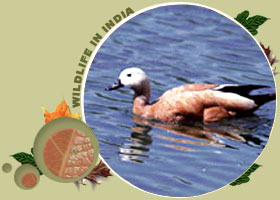Asan Barage Bird Sanctuary
Asan
Barage Bird Sanctuary is situated in the Districts of Dehradun and
recently declared as a Bird Sanctuary. The wetland at Assan Barrage, is
situated near the confluence of two rivers Assan and Yamuna. It's a
paradise for the Bird Watchers. The Assan Reservoir is a small man-made
wetland of Approx. 4 SQ. K.M. area. Assan Barrage serves as a winter
passage halt for trans-Himalayan migratory birds. These birds are
spotted here on their way to southern India (October-November) and again
on their way back (late February-March).

Temperature : summer, max.38o C, min. 14o C; winter max. 21o C, min. 2o C
Average Rainfall : 250 cm; South West monsoon during June to September.
Birding Season
Arrival & Departure
October November December March-end
Or Early April, Sometimes April- end
The Asan reservoir exists throughout the year and is fed from the river Asan and the discharge channel of Yamuna through Dhalipur powerhouse. Although the water level is controlled, it often goes down, and swampy islands in the middle become visible, attracting a variety of marsh-loving birds like Egrets, Herons and Lapwings, etc.
Wildlife Species
At the Asan Barrage Bird Sanctuary a total number of 53 species of water birds visit the Asan reservoir, of which 19 are winter migrants from Eurasia. During winter months 90% of the waterbird population comprises of 11 migratory species, namely Brahminy Duck, Pintail, Red Crested Pochard, Shoveller, Tufted Duck , Mallard, Coot, Wigeon, Common Teal, Common Pochard and Gadwall. The Asan reservoir exists throughout the year and is fed from the river Asan and the discharge channel of Yamuna through Dhalipur powerhouse. Although the water level is controlled, it often goes down, and swampy islands in the middle become visible, attracting a variety of marsh-loving birds like Egrets, Herons and Lapwings etc.
Vegetation & Flora
The aquatic vegetation of the reservoir consists of Eichhornia crassips, Potamogeton pectinatus, Typha elephantina, and Ceratophyllum demersum. The surrounding bushes include Xanthium strumarium, Eclipta prostrata, Ipomoea sp., Mimosa pudica, Achyranthus aspera, Polygonum glabrum, P. lanigerum, Aeschynomene sp., Ageratum conyzoides, phyllanthus sp., Monochoria hastata, Mosla dianthera, and Lantana camara. On the southern side, agricultural fields surround the barrage. Further south there is mixed forest in Siwaliks comprising principally Shorea robusta, Anogeissus Latifolia, Lannea coromandelica, Dalbergia sissoo, and Bombax ceiba.

Temperature : summer, max.38o C, min. 14o C; winter max. 21o C, min. 2o C
Average Rainfall : 250 cm; South West monsoon during June to September.
Birding Season
Arrival & Departure
October November December March-end
Or Early April, Sometimes April- end
The Asan reservoir exists throughout the year and is fed from the river Asan and the discharge channel of Yamuna through Dhalipur powerhouse. Although the water level is controlled, it often goes down, and swampy islands in the middle become visible, attracting a variety of marsh-loving birds like Egrets, Herons and Lapwings, etc.
Wildlife Species
At the Asan Barrage Bird Sanctuary a total number of 53 species of water birds visit the Asan reservoir, of which 19 are winter migrants from Eurasia. During winter months 90% of the waterbird population comprises of 11 migratory species, namely Brahminy Duck, Pintail, Red Crested Pochard, Shoveller, Tufted Duck , Mallard, Coot, Wigeon, Common Teal, Common Pochard and Gadwall. The Asan reservoir exists throughout the year and is fed from the river Asan and the discharge channel of Yamuna through Dhalipur powerhouse. Although the water level is controlled, it often goes down, and swampy islands in the middle become visible, attracting a variety of marsh-loving birds like Egrets, Herons and Lapwings etc.
Vegetation & Flora
The aquatic vegetation of the reservoir consists of Eichhornia crassips, Potamogeton pectinatus, Typha elephantina, and Ceratophyllum demersum. The surrounding bushes include Xanthium strumarium, Eclipta prostrata, Ipomoea sp., Mimosa pudica, Achyranthus aspera, Polygonum glabrum, P. lanigerum, Aeschynomene sp., Ageratum conyzoides, phyllanthus sp., Monochoria hastata, Mosla dianthera, and Lantana camara. On the southern side, agricultural fields surround the barrage. Further south there is mixed forest in Siwaliks comprising principally Shorea robusta, Anogeissus Latifolia, Lannea coromandelica, Dalbergia sissoo, and Bombax ceiba.
Rajasthan Camel Safari Tours
Corbett Wildlife Tours
North East Wildlife Tours
Wildlife with Taj Mahal Tours
South India Wildlife Tour Package
Rajasthan Wildlife Holiday
Tiger Safari Holiday
Luxury India Wildlife Tours
India Nepal Wildlife Tour
Ranthambore National Parks Tours
Bandhavgarh National Park Tour
Wildlife Photographic Tours To India
Tiger Tour packages
Kerala Wildlife Tour
Rajasthan with Wildlife Tours
Taj Mahal Agra & Ranthambore Tiger Tour



